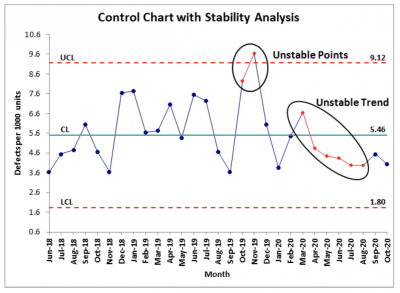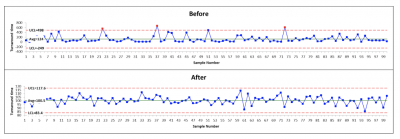
It is accepted there is variation in everything you do. If your process is stable, the variation will be predictable and controlled. But, what does that really mean, and how do you measure it? Let’s find out.
Overview: What is a stable process?
A process is said to be stable if the measures of your process parameters have both constant means and variances over time, plus a constant distribution. With a stable process, you can predict your output and measure your process capability.
A stable process can be defined as one where its variation is a result of the common cause variation of the system. The variation is due to the combination of the unique process elements and not a single identifiable special cause. This process will be steady and predictable within some expected range of variation. An unstable process can be defined as one where the variation is due to a unique, identifiable special cause that is not predictable nor expected.
The statistical tool used to distinguish between stable common cause variation and unstable special cause variation is the control chart. The control chart is constructed using actual process data. The control chart consists of a center line representing the central tendency or mean of the process and control limits representing the range or variance of the expected variation of your process.
If the control chart shows the process is exhibiting common cause variation, you can define the process as stable. If not, you will define it as unstable since you are seeing evidence of special cause variation. You can also define a stable process as one that is in-control. This will require the data points to be within the control limits and behaving in a random fashion.
The charts below show what an in-control and stable process control chart would look like as well as one that is out-of-control or unstable.


Unstable and out-of-control process
An industry example of a stable process
The finance manager of a medium-sized retailer was concerned about the turnaround time needed to process invoices. Since he had received some Six Sigma training in one of his college courses, he decided to do a quick control chart and see what it told him about his process.
The control chart is shown below.
He concluded that his process was not stable because of the number of out-of-control points. He subsequently formed a small team of finance associates who were able to bring the process into control so it was stable as well as reduce the average turnaround time. You can see that in the second control chart below.

Frequently Asked Questions (FAQ) about a stable process
1. What defines a stable process?
A process is said to be stable and in-control if it exhibits common cause variation, where the data points fall within the control limits in a random pattern.
2. How do I know if I have a stable process?
A control chart is used to indicate whether your process is demonstrating common cause variation and can be defined as being stable.
3. Can I determine process capability if my process is not stable?
No. Process capability is a forward-looking determination of what your process will be capable of doing in the future. If your process is not stable, you don’t have the degree of predictability necessary to project into the future. That is why you can only do a process capability study on a stable process.